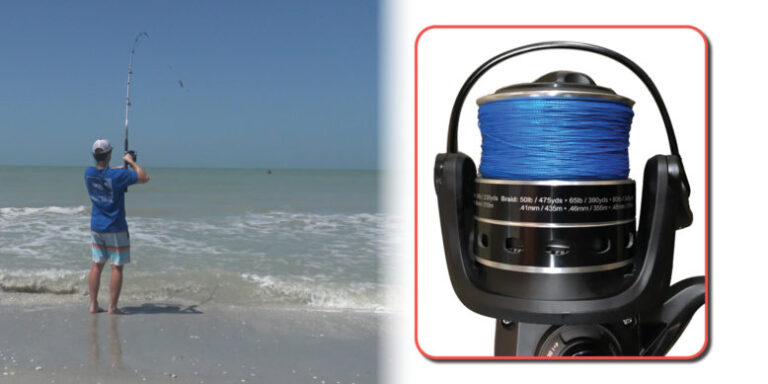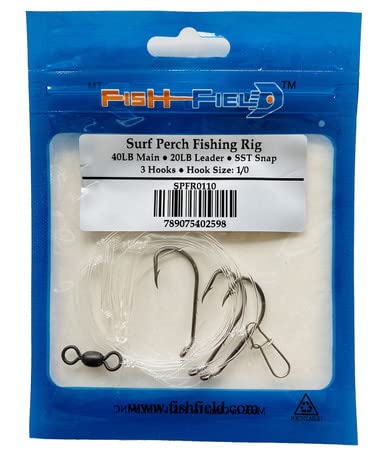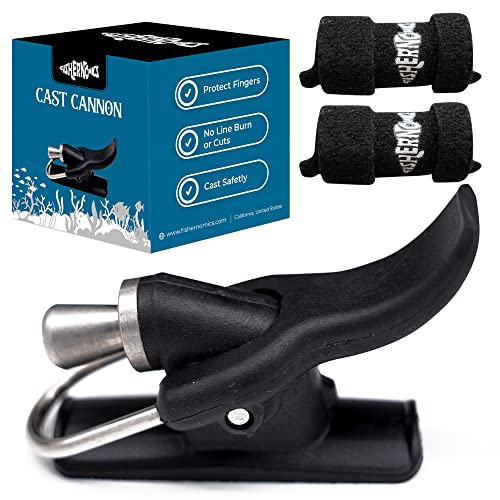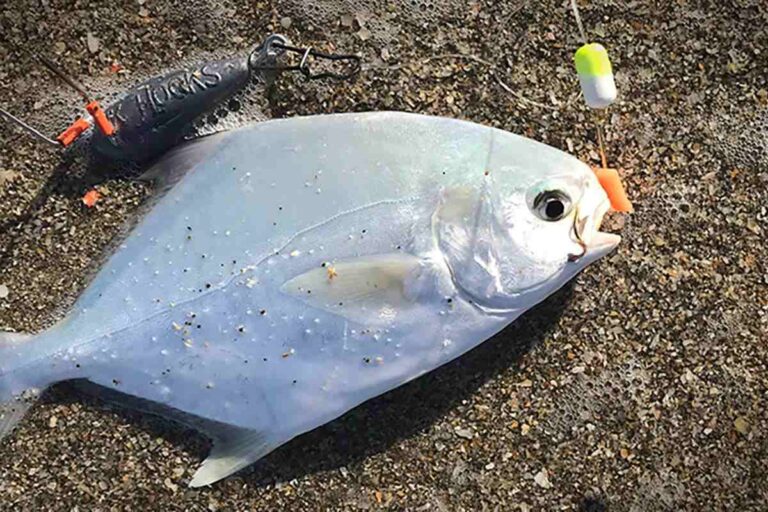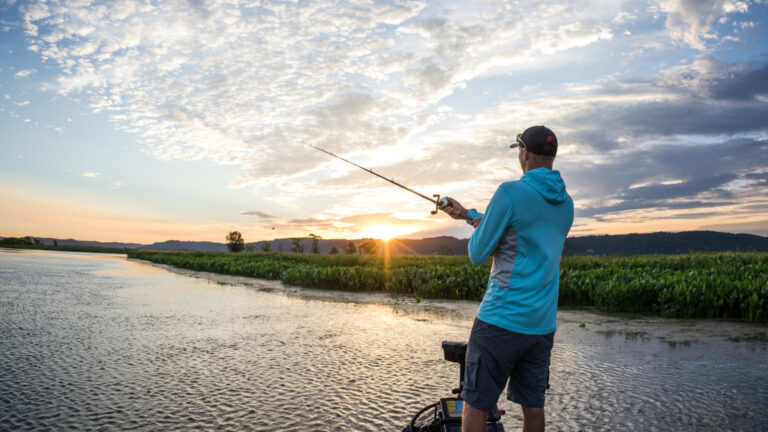To tie a shock leader for surf fishing, follow these steps: firstly, slide the shock leader through the end of the mainline, forming a loop; next, wrap the shock leader around the mainline and through the loop three to five times, taking care to keep the wraps neat and tight. Surf fishing involves casting your line from the shoreline or wading into the surf to catch fish.
To ensure you have the strength and durability needed for surf fishing, it’s important to use a shock leader. A shock leader is a length of heavy-duty monofilament or fluorocarbon line attached to the end of your mainline. It acts as a buffer to absorb the impact of casting heavy weights and prevent the line from breaking.
By tying a shock leader properly, you can increase your chances of landing bigger fish and prevent unnecessary line damage. We will provide a step-by-step guide on how to tie a shock leader for surf fishing. So let’s get started!

Credit: www.fishingmegastore.com
Understanding The Importance Of Shock Leaders In Surf Fishing
Surf fishing is an exhilarating activity that allows anglers to cast their lines from the shoreline. However, the powerful waves and strong currents can result in frequent break-offs, leaving you empty-handed and frustrated. To avoid this common frustration, it is important to understand the significance of shock leaders in surf fishing.
In this section, we will delve into the benefits of using shock leaders, ranging from preventing break-offs to improving casting distance and accuracy. So, let’s dive right in and unravel the importance of these valuable components in your surf fishing gear.
Why Shock Leaders Are Crucial For Surf Fishing
Shock leaders play a crucial role in surf fishing, providing several advantages that enhance your overall fishing experience. Here are some key points to consider:
- Withstand the force: Shock leaders are designed to endure the immense force exerted by the crashing waves and strong currents, preventing your line from snapping under pressure.
- Absorb shock: By acting as a buffer between your mainline and the fish, shock leaders effectively absorb the sudden jerks and pulls during a fight, reducing the risk of a break-off and increasing your chances of landing your prized catch.
- Protect your line: Surf fishing often involves abrasive elements such as rocks, shells, and rough sand. A shock leader serves as an extra layer of protection, shielding your mainline from potential damage caused by these hazards.
The Advantages Of Using Shock Leaders To Prevent Break-Offs
Break-offs can be incredibly disheartening, especially when you lose a fish due to the sheer force of the surf. Implementing shock leaders can significantly decrease the likelihood of break-offs. Here’s how:
- Increased tensile strength: Shock leaders are typically made of a thicker and stronger material than your mainline. This added strength enables the leader to withstand the immense pressure exerted by the surf, allowing you to tackle larger and more powerful fish with confidence.
- Shock absorption: As mentioned earlier, shock leaders absorb the sudden forces experienced while battling a fish. This shock absorption feature reduces the strain on your mainline, minimizing the chances of it breaking and ensuring you stay connected to the fish throughout the fight.
How Shock Leaders Improve Casting Distance And Accuracy
When it comes to surf fishing, casting distance and accuracy are paramount. Shock leaders contribute to enhancing these crucial aspects. Consider the following benefits:
- Added weight: Shock leaders are typically longer and heavier than your mainline. This additional weight aids in casting, allowing you to generate more momentum and achieve greater distances with ease.
- Better aerodynamics: Shock leaders streamline your cast, providing smoother movement through the air. This improved aerodynamics helps you achieve pinpoint accuracy, allowing you to target specific areas where fish are known to be feeding.
So, there you have it! By understanding the importance of shock leaders in surf fishing, you can significantly improve the overall success of your angling endeavors. These vital components not only prevent break-offs but also enhance your casting distance and accuracy.
So, don’t forget to include a shock leader in your surf fishing setup and enjoy a more fulfilling and rewarding experience on the shoreline.
Choosing The Right Shock Leader Material
Exploring Different Shock Leader Materials And Their Benefits
When it comes to surf fishing, using a shock leader is essential for preventing your line from snapping under the weight of heavy tackles and the force of powerful waves. The shock leader acts as a buffer between your main line and the fishing rig, absorbing the shock and protecting your line from breaking.
Choosing the right shock leader material is crucial for ensuring a successful and secure fishing experience. Here are some key points to consider:
- Monofilament shock leaders:
- Monofilament shock leaders are popular due to their affordability and wide availability.
- They have excellent knot strength, providing a reliable connection between your main line and fishing rig.
- Monofilament shock leaders also have some stretch, which helps absorb sudden shocks and reduces the chances of line breakage.
- However, they can be less abrasion-resistant compared to other materials, making them more susceptible to wear and tear.
- Fluorocarbon shock leaders:
- Fluorocarbon shock leaders offer superior strength and abrasion resistance.
- They are virtually invisible in water, which can be advantageous when targeting wary fish in clear conditions.
- Fluorocarbon shock leaders have less stretch than monofilament, resulting in better sensitivity and improved hook sets.
- They are more expensive than monofilament, but their durability and performance make them a preferred choice for many anglers.
- Braided shock leaders:
- Braided shock leaders are incredibly strong and offer excellent knot strength.
- They have minimal stretch, providing maximum sensitivity and better control over your tackles.
- Braided shock leaders excel in rough conditions and when targeting large or hard-fighting fish.
- Due to their thinner diameter, braided shock leaders tend to cut through the water faster, reducing drag and improving casting distance.
Factors To Consider When Selecting The Appropriate Shock Leader Material
Choosing the right shock leader material depends on various factors. Consider the following points before making your decision:
- Target fish species and size:
- Different fish species require different shock leader materials due to their varying sizes and fighting capabilities.
- Larger and stronger fish often necessitate more robust and abrasion-resistant shock leaders.
- Fishing location and conditions:
- Surf fishing in rocky areas or near structures may require a shock leader with higher abrasion resistance.
- If fishing in clear water or targeting easily spooked fish, opt for a leader with low visibility, like fluorocarbon.
- Casting distance and accuracy:
- Thinner diameter shock leaders, such as braided ones, offer less drag and can significantly enhance your casting distance.
- For precise casts, consider shock leaders with good manageability and knot strength.
Tips For Matching The Shock Leader Material To Your Fishing Conditions
To ensure you select the most appropriate shock leader material for your specific fishing conditions, keep these tips in mind:
- Research and ask for recommendations from local anglers or fishing forums based on your fishing location and target species.
- Consider the surf conditions, such as wave strength and the presence of rocks or debris, to assess the level of abrasion resistance required.
- Evaluate the visibility of your leader material under different water conditions to avoid spooking fish.
- Experiment with different shock leader materials and test their performance with your fishing tackle to find the best match for your technique and preferences.
Remember, the shock leader acts as a crucial link between you and the fish. Choosing the right material can make a significant difference in your overall fishing success and the longevity of your fishing line. Take the time to assess your unique circumstances and make an informed decision for an enjoyable and productive time on the water.
Tying The Basic Shock Leader Knot
Step-By-Step Instructions For Tying The Basic Shock Leader Knot
Tying a shock leader knot is a crucial skill for any surf angler. This knot is specifically designed to connect a heavier, abrasion-resistant leader to the mainline, ensuring you can tackle large fish and withstand the rough conditions of surf fishing.
Here are the step-by-step instructions to help you tie the basic shock leader knot with ease:
- Begin by taking the end of your shock leader and doubling it over, forming a loop. Hold the loop between your thumb and forefinger.
- Insert the doubled end of the shock leader through the eye of the fishing hook, ensuring that you have enough leader length to create your desired shock length.
- Take the free end of the doubled shock leader and wrap it around the mainline, making at least five tight turns.
- After completing the wraps, take the free end of the shock leader and pass it through the loop that you created in step 1.
- Moisten the knot with a bit of saliva or water to lubricate it, making it easier to tighten.
- Holding the free end and the mainline, gently pull both ends simultaneously to tighten the knot.
- Once the knot is snug, give it a final tug to ensure maximum strength and security.
- Trim any excess shock leader material, leaving a small tag end of about 1/4 inch.
- Test the knot by giving it a firm pull to make sure it holds up and doesn’t slip under pressure.
- Congratulations! You have successfully tied the basic shock leader knot. Repeat these steps whenever you need to connect a shock leader to your mainline for surf fishing.
Common Mistakes To Avoid When Tying The Knot
When tying the basic shock leader knot, there are a few common mistakes that anglers tend to make. Avoid these errors to ensure your knot is strong and reliable:
- Rushing the process: Take your time to tie the knot correctly, as rushing can lead to a weak connection that may cause the leader to break under pressure.
- Insufficient wraps: Ensure that you make at least five tight wraps of the shock leader around the mainline. Insufficient wraps can weaken the knot and increase the risk of failure.
- Over-tightening: While it’s important to snugly tighten the knot, avoid pulling it excessively tight. Over-tightening can damage the shock leader material or cause the knot to slip.
- Not moistening the knot: Lubricating the knot with saliva or water is crucial as it helps reduce friction, making it easier to tighten and ensuring a secure hold.
- Neglecting to test the knot: Always give the knot a firm pull after tightening to test its strength and reliability. Neglecting this step may leave you unaware of a weak knot that can fail when facing a powerful fish.
Tips For Ensuring The Knot Is Secure And Reliable
To ensure that your basic shock leader knot is secure and reliable, consider the following tips:
- Use the appropriate shock leader material: Choose a shock leader material that is strong, abrasion-resistant, and suited for the size of fish you are targeting.
- Opt for a shock leader length that matches your fishing conditions: Adjust the length of your shock leader based on the surf conditions and the fish species you are pursuing. A longer shock leader provides greater leverage against strong waves and sharp rocks.
- Wet your hands before handling the leader and mainline: Moist hands prevent any oils or dirt from transferring to the knot, reducing the risk of slippage or weakening.
- Trim any excess leader material: Leaving a short tag end of about 1/4 inch minimizes the chances of the knot catching on rod guides during casting or retrieval.
- Inspect the knot periodically: Regularly check your knot for any signs of wear or damage. If you notice any flaws, re-tie the knot to maintain its integrity.
By following these step-by-step instructions, avoiding common mistakes, and implementing these tips, you’ll be well-equipped to tie a strong and reliable basic shock leader knot for your surf fishing adventures. Happy fishing!
Advanced Shock Leader Tie Techniques
Exploring Alternative Knot Options For Specific Fishing Scenarios
- When it comes to surf fishing, using a shock leader is essential to prevent your main line from breaking when casting heavy weights or landing larger fish. While there are several knot options for tying a shock leader, it’s important to understand that different fishing scenarios may require different tie techniques. Here are some alternative knot options worth exploring:
- Uni knot: A versatile and easy-to-tie knot, the uni knot is a popular choice for beginners as well as experienced anglers. It provides good strength and can be used in various fishing situations.
- Improved blood knot: Known for its strength and reliability, the improved blood knot is commonly used for attaching monofilament or fluorocarbon shock leaders to your main line. It’s especially effective when using lines of different diameters.
- Albright knot: If you’re fishing with a braided main line and need to attach a heavier shock leader, the albright knot is the way to go. This knot works well with different line types and ensures a smooth transition between the main line and shock leader.
- Fg knot: Arguably one of the strongest and most reliable knots for connecting braided main lines to fluorocarbon or monofilament leaders, the fg knot is perfect for targeting trophy-sized fish. It requires some practice to master but is definitely worth learning.
- Nail knot: While not as commonly used for shock leader connections, the nail knot can be handy when attaching a shorter length of shock leader directly to a fly line. It’s a compact and strong knot that provides a streamlined connection.
Step-By-Step Instructions For Tying Advanced Shock Leader Knots
- To ensure a secure and reliable connection between your main line and shock leader, follow these step-by-step instructions for tying advanced shock leader knots:
- Step 1: Begin by doubling up a section of your shock leader, creating a loop that is approximately 6-8 inches long.
- Step 2: Pass the looped section through the eye of your main line or swivel.
- Step 3: Hold the looped section and the main line or swivel tightly with one hand, while using your other hand to create 10-12 wraps around both lines with the tag end of the shock leader.
- Step 4: Take the tag end of the shock leader and pass it back through the loop at the opposite side of the wraps.
- Step 5: Moisten the knot with saliva or water and gradually tighten the knot by pulling the main line, shock leader, and tag end simultaneously.
- Step 6: Trim any excess tag end, leaving a small stub for added security.
- Step 7: Test the knot by applying gradual pressure and inspect for any slippage or weakness.
When And Why To Use Different Tie Techniques Based On Fishing Conditions
- The tie technique you choose for your shock leader can greatly impact your success in different fishing conditions. Here’s when and why you should consider using different tie techniques:
- Uni knot: Use the uni knot when fishing in moderate surf conditions or targeting smaller species. It offers a good balance between strength and ease of tying.
- Improved blood knot: Opt for the improved blood knot when fishing in rougher conditions or targeting larger fish. Its strong and reliable connection ensures minimal chances of failure.
- Albright knot: When using a braided main line and fishing in areas with structure or heavy current, the albright knot is your go-to. It allows a smooth transition between lines and provides excellent strength.
- Fg knot: Consider using the fg knot when targeting trophy-sized fish or fishing in clear water with skittish species. Its slim profile and high strength make it less visible and more effective.
- Nail knot: Reserve the nail knot for situations where you need to attach a short shock leader directly to a fly line, such as fly fishing in still waters or delicate presentations.
Remember, choosing the right shock leader knot depends on various factors, including the fishing conditions, target species, and type of gear you’re using. Experiment with different knots and practice tying them before heading out to maximize your chances of success.
Inspecting And Replacing Shock Leaders Regularly
How To Visually Inspect Shock Leaders For Signs Of Wear And Damage
When it comes to surf fishing, having a strong and reliable shock leader is essential. A shock leader is a thicker, heavier line that serves as a buffer between your main line and the fish you’re trying to land. Over time, shock leaders can become worn or damaged, compromising their performance.
To maintain optimum fishing performance, it’s important to regularly inspect your shock leaders for signs of wear and damage. Here are a few key points to keep in mind:
- Check for abrasions: Inspect the entire length of your shock leader for any signs of abrasions. Look for frayed or worn spots, as these can weaken the line and make it prone to breaking during a cast or when fighting a fish.
- Look for knot weakness: Pay close attention to the knots on your shock leader. Knots can weaken over time, especially if they have been repeatedly cast or put under heavy strain. Make sure to inspect the knots for any signs of fraying or unraveling.
- Inspect for nicks and cuts: Carefully run your fingers along the length of the shock leader to feel for any nicks or cuts. Even small nicks can weaken the line and make it more susceptible to breaking.
- Check for stretch: Give your shock leader a gentle tug to check for any stretch. Shock leaders that have lost their elasticity will be less effective at absorbing the impact of a cast and may increase the chances of the line breaking.
Regularly inspecting your shock leaders for signs of wear and damage will help ensure that they are in optimal condition for your surf fishing adventures.
When To Replace Shock Leaders To Maintain Optimum Performance
Knowing when to replace your shock leader is crucial to maintaining optimum fishing performance. A worn or damaged shock leader can lead to lost fish and missed opportunities. Here are some key indicators that it’s time to replace your shock leader:
- Visible sign of wear: If you notice any fraying, abrasions, or cuts on your shock leader, it’s time for a replacement. These signs of wear can weaken the line and increase the risk of failure.
- Knot failure: If your shock leader knots start to unravel or show signs of fraying, it’s a clear indication that it’s time to replace the line. Weak knots can lead to line breakage during casting or when reeling in a fish.
- Loss of elasticity: Shock leaders are designed to have some level of stretch or elasticity. If your shock leader feels stiff and lacks the necessary flexibility, it’s time to replace it. A lack of elasticity can reduce the shock-absorbing capacity of the line and increase the chances of breaks.
Replacing your shock leader at the first sign of wear or damage will ensure that you are always using a reliable and effective line for your surf fishing endeavors.
Tips For Extending The Lifespan Of Your Shock Leaders
To make the most of your shock leader and extend its lifespan, there are a few simple steps you can take. By implementing these tips, you can increase the durability and performance of your shock leader:
- Clean after each outing: Rinse your shock leader with freshwater after every fishing trip. This will help remove any salt, sand, or debris that can cause abrasions or damage to the line.
- Store properly: Avoid leaving your shock leader exposed to direct sunlight or extreme temperatures when not in use. Storing it in a cool, dry place will help prevent premature aging or degradation.
- Inspect regularly: As mentioned earlier, make it a habit to visually inspect your shock leader before each fishing excursion. This will allow you to identify any wear or damage in a timely manner and take appropriate action.
- Retie knots: If you detect any weakness or fraying in your shock leader knots, take the time to re-tie them. This will help maintain the strength and integrity of your line.
- Use protective gear: Consider adding a shock leader sleeve or tape near your knot and connection points. These protective measures can help reduce friction and minimize wear.
By following these simple tips, you can prolong the lifespan of your shock leaders and ensure they remain reliable and effective on your surf fishing adventures.
Safety Considerations When Using Shock Leaders
Understanding The Potential Dangers Of Using Shock Leaders
When it comes to surf fishing, using a shock leader can greatly increase your chances of success. However, it is important to understand that there are potential dangers associated with using shock leaders. Here are some key points to keep in mind:
- The main purpose of a shock leader is to absorb the force generated by a powerful cast. This can prevent your line from snapping and potentially causing injury to yourself or others.
- Shock leaders are typically made of heavy-duty monofilament or fluorocarbon line, which can be more abrasive than regular fishing line. It is important to handle them with care to avoid cuts or abrasions.
- Casting with a shock leader requires more strength and effort compared to using regular line. You need to be prepared physically and mentally to handle the increased force generated during the cast.
- In windy conditions, the force exerted on the shock leader can be even greater. Take extra caution and adjust your casting technique accordingly to avoid any accidents.
- Be mindful of your surroundings when casting with a shock leader. Ensure that there are no people or obstacles in close proximity that could be hit by your casts.
Safety Precautions To Follow To Avoid Injury
To ensure the safety of yourself and those around you while using shock leaders for surf fishing, it is crucial to follow these safety precautions:
- Always wear protective eyewear when casting with a shock leader. This will protect your eyes from any potential line snapbacks or flying debris.
- Avoid using shock leaders that are excessively long or too heavy for your casting capabilities. Match the length and strength of the shock leader to your fishing conditions and casting abilities.
- Regularly inspect your shock leader for any signs of wear and tear, such as fraying or knots. Replace it immediately if it shows any signs of damage to prevent accidents.
- Practice your casting technique in a safe and open area before venturing out to the surf. This will help you gauge the force required and prevent any accidents due to improper casting techniques.
- Communicate with your fishing buddies and ensure they are aware of your intentions to cast with a shock leader. By maintaining good communication, you can prevent accidents and ensure everyone’s safety.
- Finally, be mindful of the weather conditions before heading out to fish. High winds or rough surf can significantly increase the force exerted on your shock leader, making it crucial to assess if it is safe to fish.
Tips For Ensuring Safe And Responsible Use Of Shock Leaders
To ensure safe and responsible use of shock leaders while surf fishing, consider the following tips:
- Familiarize yourself with local fishing regulations and guidelines. Some areas may have specific restrictions or requirements regarding the use of shock leaders. Adhering to these rules will not only guarantee your safety but also help protect the environment.
- Invest in quality shock leaders from reputable brands. Cheaper alternatives may compromise the strength and reliability of your shock leader, increasing the risk of accidents.
- Take the time to properly tie your shock leader to the mainline using a reliable knot. This will ensure that the connection is strong and secure, reducing the chances of any mishaps during casting or reeling in.
- When not in use, store your shock leaders properly to prevent tangling or damage. Keeping them organized and protected will extend their lifespan and maintain their overall integrity.
- Educate yourself on proper casting techniques specific to using shock leaders. Understanding how to distribute force efficiently during the cast will help minimize the risk of injury and maximize your casting distance.
By understanding the potential dangers, following safety precautions, and implementing responsible use of shock leaders, you can enjoy a safer and more successful surf fishing experience. Stay vigilant, stay prepared, and enjoy the thrill of surf fishing without compromising your safety or the safety of others.
Recap Of Key Takeaways
Plain paragraph: before diving into the step-by-step guide on tying shock leader knots for surf fishing, let’s recap the key takeaways about the importance of shock leaders and the factors to consider when choosing the right materials.
Key points:
- Shock leaders are essential in surf fishing as they protect the main fishing line from abrasion caused by the rough surf environment.
- They absorb the initial force when casting heavy sinkers or lures, preventing the main line from breaking.
- Shock leaders also enhance casting distance, allowing you to reach deeper waters where big game fish are often found.
Summary Of The Importance Of Shock Leaders In Surf Fishing
Bullet points:
- Shock leaders protect the main line from abrasion and potential breakage in the rough surf environment.
- They absorb the shock and force during casting, preventing the main line from snapping.
- Using shock leaders improves casting distance, enabling anglers to reach deeper waters where larger fish are typically found.
- The increased diameter of shock leaders reduces the risk of wind knots and tangles.
- They provide a strong connection between the main line and the terminal tackle, increasing overall fishing success.
Key Considerations When Choosing Shock Leader Materials
Plain paragraph: selecting the right shock leader materials is crucial to ensure optimal performance and durability throughout your surf fishing adventures. Here are some key considerations to keep in mind:
Key points:
- Material strength: Choose shock leader materials with high tensile strength to withstand the intense forces experienced in surf fishing. Monofilament, fluorocarbon, and braided lines are commonly utilized.
- Diameter and poundage: Match the shock leader diameter and poundage to the main line being used. Opt for a diameter approximately 2-3 times thicker than the main line.
- Abrasion resistance: Look for shock leaders with excellent abrasion resistance to withstand the harsh saltwater conditions and the abrasive nature of sandy bottoms.
- Visibility: Consider the visibility of the shock leader material. In clear water, opt for low-visibility options such as fluorocarbon, while in murky or turbulent conditions, visibility is less of a concern.
- Knot strength: Ensure that the chosen shock leader material has reliable knot strength. Some materials are more prone to knot slippage than others, so choose ones that allow for secure knots.
Step-By-Step Guide To Tying Basic And Advanced Shock Leader Knots
Bullet points:
- Basic shock leader knot
- Start by folding the shock leader over itself, creating a double line.
- Tie an overhand knot with the double line, leaving a small loop at the end.
- Pass the loop through the eye of the swivel or hook.
- Hold the loop and the double line, and tie another overhand knot below the first knot.
- Tighten both knots by pulling the double line and the main shock leader line simultaneously.
- Trim any excess leader material.
- Advanced shock leader knot: Albright knot
- Double the main line and feed the end through the eye of the shock leader.
- Create a loop with the main line and hold it alongside the shock leader.
- Use the end of the main line to wrap around both the main line and the shock leader, making 8-10 wraps.
- Pass the end of the main line through the loop created and then back through the large loop formed by the wraps.
- Moisten the knots and tighten slowly, ensuring they seat properly.
- Trim any tag ends.
Remember, practice makes perfect when it comes to tying shock leader knots. Experiment with different techniques and materials until you find what works best for your surf fishing needs. Happy fishing!
Final Thoughts
The Impact Of Mastering Shock Leader Tie Techniques On Surf Fishing Success
When it comes to surf fishing, mastering the art of tying a shock leader can have a significant impact on your success. The shock leader acts as a buffer between the mainline and the terminal tackle, absorbing the force of a powerful cast and preventing the line from breaking.
By perfecting your shock leader tie techniques, you can enhance your surf fishing experience in the following ways:
- Increased casting distance: A well-tied shock leader allows you to achieve greater casting distances with ease. It minimizes line snap and improves the overall efficiency of your cast, helping you reach those elusive surf fishing hotspots.
- Enhanced line protection: Surf fishing involves battling with strong currents, rough waves, and abrasive sandy bottoms. When using a shock leader, your mainline remains safeguarded from any potential damage caused by these harsh elements. This protection prolongs the life of your fishing line, saving you from frequent replacements.
- Improved fish landing ratio: As any angler knows, hooking a fish is just the first step. Successfully reeling it in without the line breaking is equally crucial. A shock leader provides the necessary strength to withstand the intense pressure exerted by large fish, improving your chances of landing them successfully.
Encouragement To Practice And Refine Shock Leader Tie Skills
Like any skill, tying a shock leader requires practice and refinement. Here are some key points to keep in mind as you hone your shock leader tie skills:
- Patience and precision: Take your time when tying a shock leader to ensure each knot is secure. Developing precise knot-tying techniques will help in creating durable connections that won’t unravel under pressure.
- Use appropriate materials: Invest in high-quality shock leader material that suits the surf fishing conditions you typically encounter. Different environments may require different strengths and diameters, so choose accordingly.
- Seek guidance and learning resources: There are numerous videos, tutorials, and guides available online that demonstrate various shock leader tie techniques. By exploring these resources, you can gather invaluable tips and techniques that can elevate your knot-tying skills.
- Practice makes perfect: Head to a quiet spot with your fishing gear and practice tying shock leaders repeatedly. The more familiar you become with the process, the quicker and more efficient your ties will be in real fishing situations.
Closing Remarks On The Benefits Of Using Shock Leaders In Surf Fishing
Utilizing a shock leader while surf fishing offers numerous advantages that can significantly enhance your overall fishing experience. The benefits include increased casting distance, enhanced line protection, and improved fish landing ratios. By dedicating time to practice and refine your shock leader tie skills, you’ll become more confident in your tackles and better equipped to tackle the challenges of surf fishing.
So, embrace the art of tying a shock leader and elevate your surf fishing game to new heights. Happy fishing!
Conclusion
When it comes to surf fishing, knowing how to tie a shock leader is crucial for success. By following the steps outlined in this guide, you’ll be able to confidently secure your fishing line and prevent it from breaking when faced with the powerful force of a big catch.
Remember to choose the right type and pound test for your shock leader, and always ensure that your knots are tight and secure. Practice tying the knot before heading out to the water, so you can tie it quickly and efficiently when the time comes.
With this newfound knowledge and skill, you’ll be ready to tackle bigger fish and enjoy a more rewarding surf fishing experience. So, grab your fishing gear and get ready to make some unforgettable catches!


